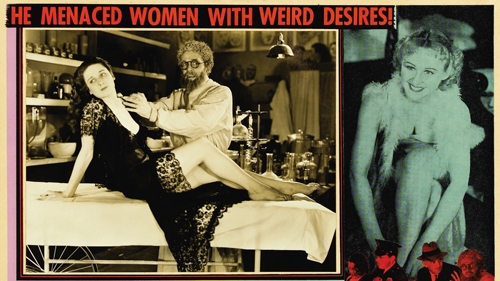Schlock Value: Nightmare in Wax (1969)
Hey Schlockers! This week, I’m taking a little trip back to the late 1960s to check out a little piece of drive-in trash that Crown International Pictures produced to cash in on the popularity of other classic wax museum thrillers. That’s right, I’m talking about Nightmare in Wax. At the time of its release, the most popular of these was André De Toth’s brilliant House of Wax, which had been released over fifteen years prior. While House of Wax had its flashy 3D presentation and horror legend Vincent Price to get asses in seats, all Nightmare in Wax had to offer was that it was “in color.”
Its director, Bud Townsend, was no one particularly special (he had come from directing TV and eventually went on to direct the classic Alice in Wonderland: An X-Rated Musical Fantasy) and its star, Cameron Mitchell, was a seasoned B-movie veteran who had previously starred in Mario Bava’s Blood and Black Lace, but spent most of his career in and out of cheap thrillers and westerns. One thing’s for sure: he was no Vincent Price. Despite all this, I will say the poster is a lot of fun. The title, Nightmare in Wax, oozes down in a tacky seafoam green hue beneath the grotesque visage of an eyepatch-wearing Cameron Mitchell and his shrieking blonde victim, while the ad copy promises “unbearable horrors” and a “chamber of torture.” So yeah, okay, I’ll give this one a shot.
The film opens at a swanky Hollywood party, celebrating the release of the latest film from Paragon Pictures. Here, we are introduced to Marie Morgan, a beautiful starlet who announces her engagement to the film’s handsome star, Tony Dean. As Tony heads home for the evening, he is attacked inside an elevator by an unknown assailant. The following day at a wax museum, we meet Vincent Renard (Mitchell), a former Hollywood makeup artist who is now the proprietor of the museum. As he stands around wearing an eye patch, brooding and generally looking miserable with his scarred face, the caretaker/tour guide leads a group of tourists through the museum and we see a display of three Paragon Pictures stars who have recently gone missing, with plans to add Tony Dean as the fourth. Coincidence? As Renard retreats to his lab, complete with a giant vat of hot wax, Detective Haskell and his partner arrive to question Renard and check out the new bust of Tony Dean. After Renard side-steps the detectives’ questions, we learn that both Renard and Max Black, the head of Paragon Pictures, have romantic links to Marie Morgan, as well as personal connections to Tony Dean, and two other missing people who also happen to be part of the new wax figure display.
At this, we flash back to another Hollywood party. This time, Renard has two good eyes, no facial scar, and he’s still with Marie. When he urges her to leave the studio and retire so they can begin their life together, Max becomes furious and tosses his glass of wine into Renard’s face as he lights a cigarette (with the largest flame I’ve ever seen come from a lighter), resulting in Renard’s face immediately catching fire. Despite this happening in a room full of people, the incident was ruled an accident, basically leaving Renard a broken shell of a man for the rest of his life. When the film cuts back to the present, the cops are gone, and Renard receives a phone call from Marie who would like to meet up for dinner. After the call, we hear someone chanting, “Hello, Marie.” The camera pans, and we see that it’s Tony Dean! Not only is he not dead, but Renard has been keeping him frozen in place with a mysterious serum.
When Renard meets up with Marie, he learns that she wants to commission him to create a wax sculpture of Tony, which is not awkward at all. He agrees on the condition that she pose for him to become a wax figure also. Double awkward. Afterward, Renard heads to a club (because it’s the ‘60s) and meets Theresa, a ditzy young blonde who just so happens to be dating Max. He invites her back to his museum to give her a tour and maybe pose for him, and hey, why not bring Max with you? Meanwhile, Max meets with acclaimed director Alfred Herman, who is working on a new suspense thriller for Paragon Pictures (he also is notorious for appearing in small cameos in his films, wink wink). Max has the bright idea that shooting it inside the wax museum would be a great way to pay homage to the actors who have recently gone missing. Now, everyone is heading to the museum.
When Max and Theresa arrive to check out the new wax bust of Theresa’s head, Renard reveals that he has drugged Max’s wine. Cue: evil villain monologue where Renard explains how he’s been secretly kidnapping his rivals and putting them on display in his museum (as if we didn’t already know that). What follows is a convoluted series of lengthy sequences involving Renard stalking Theresa through his macabre menagerie, stealing Max’s car and running from the cops in order to frame Max for Theresa’s murder, and a thunderstorm “reviving” the wax figures (because apparently electricity counteracts whatever freezing the magic serum does). When Renard finally returns to the museum, Marie shows up to see the Tony Dean sculpture, then the detectives arrive to question Renard some more, and Renard, losing sanity by the second and frantic to complete his work, attempts to drop Max into the vat of wax, risking capture or even becoming a permanent addition to the museum himself.
Okay, look. I can’t imagine anyone involved with Nightmare in Wax thought they were making anything more than a cheap shocker to be tacked onto a drive-in double-feature and maybe make some easy cash. It’s pretty clear from the beginning that they just borrowed some bits and pieces from better movies and phoned in the rest. The sets are shoddy and appear to have been lit by someone who saw a giallo film once, the makeup is amateurish at best (Renard’s scar really just looks like a big grey smudge on his face with some liquid latex), and the script is so overwritten, it makes 96 minutes feel like an eternity. Since it’s clear after from the moment he appears on screen that Renard is the guilty party, there’s little to no tension or mystery to be found, and one has to wonder how the detectives didn’t solve the case of the missing actors sooner. In fact, there’s very little about the film that makes any sense at all, from bizarre character choices and motivations like Renard’s incredibly flawed home-brewed secret serum which makes kidnapping people and turning them into wax figures far less efficient than just straight up killing them to Max setting Renard’s face on fire in a room full of people without anyone noticing.
In what world does this movie take place? Fortunately, despite all of this, Cameron Mitchell, B-movie veteran that he was, does a pretty decent job with the material, devouring the scenery at every opportunity. And the ridiculous twist ending does actually resolve some of the problems with the film’s nonsensical logic. Is it great? No, not really, but it does more to help the film than just about anything else.
Nightmare in Wax seems like it might be a good time on the surface, but unless you’re really into wax museum horror films, I’d say give this one a pass. It’s not a complete failure, but there’s really not enough good stuff in it to warrant a recommendation. Plus, unless there’s a restored version around somewhere, the public domain transfer floating around in Mill Creek’s box sets and on YouTube has an abysmal audio track. I’m not kidding when I say I struggled to understand what was being said for half of the movie. Just go watch House of Wax instead.















